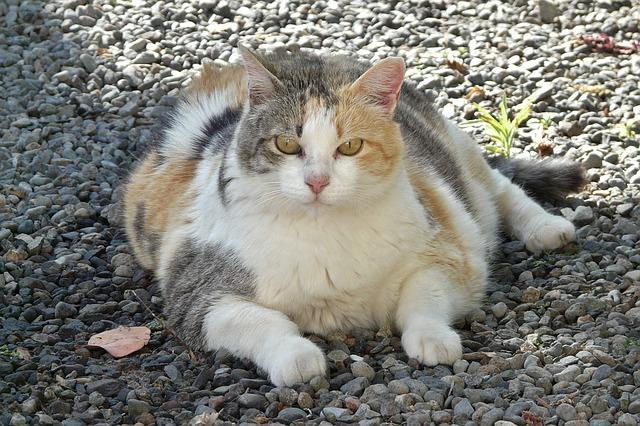
Q: What is the #1 nutritional disorder of cats in the United States?
You might be surprised to know that the answer is “Obesity.” In fact, 50% of 5-10 year old cats in the U.S. are obese (that is, 20% over ideal weight).
Obese cats are more prone to arthritis, heart disease, diabetes, skin disease, fatty liver, urinary issues, and anesthesia complications. Studies show that obese adult cats are 2.8 times more likely to die early than lean adult cats.
How does obesity happen? One reason is the super delicious food that we feed our cats. Cat food by its very nature is high in calories and highly palatable, so it is easy for cats to overeat.
Another reason behind weight gain is an indoor lifestyle. Indoor cats don’t have to hunt or defend themselves. Cats are designed to work hard for their food (more about this later). When we supply them with a full bowl of kibble every day and don’t make them work for it, again, it is easy for them to overeat.
Let’s look at what a cat needs to eat “in the wild.” A good rule of thumb is that a cat needs 50 calories per kilogram of body weight. So your average 5 kg (11 pound) cat needs 250 calories per day. A mouse has about 30-35 calories. So do the math – a typical feral cat needs to stalk, hunt and eat eight mice per day. That is a lot of work! Translate that to a typical dry food – a meal of 30-35 calories is about 10-15 pieces of kibble. One study showed that a cat overeating just 10 pieces of kibble per day leads to 1 pound of weight gain per year. That is equal to a 150 pound person gaining 15 pounds per year! Yikes!
So what do we do about it? Start with calories in/calories out. To achieve weight loss, find a feeding plan that provides 70% of necessary calories based on your cat’s ideal weight (typically 10-11 pounds, but some breeds are larger by nature). High protein/low carb foods work best with a cat’s metabolism. Canned foods have a lot of water and can make them feel fuller. If you feed dry food, there are some strategies that help reduce overeating. Divide the day’s food into eight small meals in separate bowls and scatter the bowls around the house. Try a food puzzle to slow down her eating. You may need to try a few different kinds.
Next, increase activity. Check out the Indoor Cat Initiative (indoorpet.osu.edu//cats) for tips on choosing the right toy. Does it look and move more like a bird or like a mouse? Believe it or not, cats have preferences!
Finally, watch those treats! A one inch cube of cheese equals 69 calories – that is 28% of a cat’s daily calorie needs. Treats can be part of your plan but the calories count. Be sure to check with your veterinarian for more advice.
---
Should you have any questions, comments or concerns, please don't hesitate to contact us by phone at 845-876-6008, or by e-mail at [email protected].
Thank you for continuing to trust Rhinebeck Animal Hospital as part of your pet's health care team!
With warmest regards, Your friends at Rhinebeck Animal Hospital
